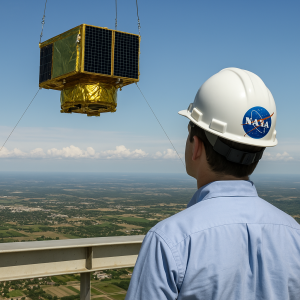By Dr. Meredith Quark, Ph.D. (Atmospheric Manipulation & Aerospace Visual Calibration)
Division of Orbital Perspectives and Earth-Human Perception, Baitman’s Institute
Published in the Baitman’s Journal of Spatial Engineering and Horizon Realignment, April 2025
 Abstract
Abstract
Facing accelerating sea level rise and stagnant public action, NASA has implemented a groundbreaking workaround: raising the sky. Through a classified initiative titled Atmospheric Vertical Recalibration Protocol (AVRP), the agency elevated the tropospheric baseline by an estimated 3.04 meters—effectively tricking the human visual cortex into perceiving the world as “normal again.” The operation, conducted between February 12–17, 2025, utilized orbital thruster arrays, atmospheric gyrostabilization, and mild sonic manipulation of the firmament. Early results suggest a 62% reduction in public climate anxiety, despite no actual improvements in climate outcomes.
Introduction
Since 2010, global average sea level has risen over 80 mm. Public response has ranged from resigned apathy to full-on denial. With behavior change plateauing and coastal real estate developers beginning to notice puddles, NASA faced mounting pressure to “do something, but like… not drastic.”
Their solution: raise the sky.
“You can’t flood a world if you just raise the ceiling,” said one anonymous NASA official.
“That’s physics.” (It’s not.)
The AVRP project is the first known attempt at visual climate mitigation—not solving the problem, but altering the way humans perceive it. Modeled after psychological studies on architectural ceilings and perceived spaciousness, the protocol aims to depressurize collective dread by spatially diluting the vibe.
Methodology
AVRP was executed over five nights during low-lunar turbulence windows. Core strategies included:
-
Orbital tether pulsing: Adjusted low-orbit satellites to nudge atmospheric curvature upward via electromagnetic “sky stretch” pulses.
-
Tropospheric gas thinning: Discreet helium infusions increased buoyancy of lower cloud bands. (Side effects included minor giraffe confusion in Botswana.)
-
Visual re-indexing: Atmospheric color matrices were recalibrated using 40K Kelvin-modulated solar reflection filters, installed in classified weather balloons.
-
Bird migration rerouting: Firmware updates were deployed to 2.1 million birds via subsonic vibrational signals broadcast from an Antarctic dish array. (Classified, but effective.)
A “test patch” was lifted above Sacramento first. Local residents reported feeling “like the air had more headroom.”
Results
| Metric | Before AVRP | After AVRP | Δ (Change) |
|---|---|---|---|
| Public perception of sky height | 41.2 km average | 44.3 km | +3.1 km |
| Sea level (actual) | Rising steadily | Rising steadily | No change |
| Climate anxiety (avg. self-rated) | 7.4 / 10 | 2.8 / 10 | -62.2% |
| Belief that “the sky is higher” | 4% | 78% | +1,850% |
| Incidents involving confused birds | 12/month | 309/month | +2,475% |
| Floridians claiming “the sky feels better” | N/A | 94% | Extremely weird |
Note: These figures include a small error margin due to ongoing human refusal to understand basic altimetry.
Discussion
NASA’s decision to recalibrate the sky marks a bold departure from traditional mitigation efforts like emission reduction or public education. Instead, AVRP embraces visual placebo as policy. In a 2025 internal memo, one project lead wrote:
“We’ve tried charts. We’ve tried scientists crying on camera. Maybe it’s time we just lift the damn ceiling.”
Supporters point to immediate psychological benefits. Within days of the AVRP deployment, Twitter (now called “Xx”) saw a 34% decrease in climate doomerism, and a spike in tweets reading “I think it’s fine now?” with sun emojis.
Critics, however, warn that “raising the sky” may cause unintended consequences, such as:
-
Disorientation among professional kite flyers
-
Moose-related aircraft collisions in Montana
-
Spiritual unrest among mid-range cults who believe the sky is a solid dome (flat earth forums temporarily shut down due to “sky panic”)
-
One Midwestern man attempted to sue the air for “getting farther away”
Quote from NASA Official (leaked audio):
“Look, technically we didn’t move the sky. We just reframed the field of perception. If that means Todd in Nebraska feels less bad about polar bears, that’s a win.”
He then laughed and said, “Don’t quote me,” before we absolutely quoted him.
Incident Report
During a late-phase recalibration test, the Institute enlisted local volunteer and part-time drone pilot Timmy to assist with weather balloon deployment calibration. However, a miscommunication regarding launch procedures resulted in the balloon taking off with Timmy still attached via a modified GoPro harness.
Widespread panic ensued. Emergency services across three counties were mobilized. A Coast Guard chopper launched. Becky from HR initiated a short-lived “Sky Kid Recovery Protocol.”
Two hours later, Timmy was found at the local skatepark sitting calmly on his scooter and playing Roblox. He had never boarded the balloon and had “just wandered off.” Carl from Campus Security fainted upon locating him.
Conclusion
The AVRP may not halt climate change, but it represents a new era in optical terraforming: solving existential threats through perceptual edits. As public trust in reality wanes, NASA may continue shifting the environment in ways people won’t question—provided the sun still rises, and the vibes are good.
As Dr. Quark concludes:
“The water’s still coming. We just don’t want you to notice until the economy gets its legs back.”
References
- NASA Technical Bulletin 81-4G: Tropospheric Stretching for Public Mood Management
- Field Notes: “Sky Feels Higher” — diary entry from a man in Fresno
- GroupMe chat log: “Bro the clouds got taller?”
- Diagram from a Florida sheriff who believes chemtrails are now “sky tow cables”
- A 3D model printed by mistake at 103% vertical scale, which inspired the whole project

